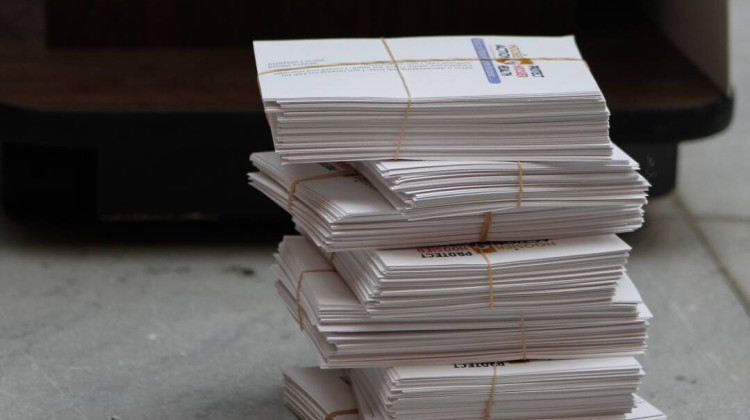
Gov. Eric Holcomb often brags about the Indiana Women’s Prison. Last year, Holcomb showed the prison off to Ivanka Trump. He’s mentioned the prison in his state of the state address and posted videos to his Facebook page.
“I wanted to be at your graduation because of what it symbolizes for you and your families and for the state of Indiana,” he said at the 2018 graduation ceremony for The Last Mile, a program that teaches inmates how to code. “We’re all in this together.”
But critics say such statements are insincere, given the current situation — with prisoners confined to their cells for long stretches amid the grueling summer heat. Some employees at the prison worry prisoners could die if conditions persist.
State Sen. J.D. Ford (D-Indianapolis) whose district includes the prison, says, “It’s kind of offensive that Gov. Holcomb swings through and does a photo op, but when we are reaching back to him asking for help, we have not gotten it.”
Since the early days of the coronavirus pandemic, as Side Effects previously reported, many women in the prison have been locked in their cells with few opportunities for relief. In units known as the “cottages,” prisoners and advocates say the conditions are anything but quaint: The rooms lack toilets and running water, and each houses two to four inmates, who report stifling temperatures much hotter than outside.
Bathroom breaks come at the availability of correctional officers, who are each responsible for guarding dozens of women and must unlock each cell door individually. Some inmates have had accidents in their cells because of long wait times or stuck doors, so many stay dehydrated. Some have even stopped taking certain medications that may cause their bodies to produce more urine.
The manual locks have also raised fire safety issues — the women worry they’ll be left for dead before an officer or first responders can get them out.
“This is a ticking time bomb,” says one prison employee, who talked with Side Effects on the condition of anonymity because they didn’t have permission to speak to the media. “I think it’s just a matter of time until something really bad happens.”
The employee says the measures have been particularly harsh for new inmates, who are quarantined upon their arrival and have spent more time locked in their cells. They also said that some correctional officers respond slowly, if at all, to potential medical problems.
“Maybe you’ve gotten lucky so far, but one of these days, you’re gonna open that door and somebody’s gonna be dead,” the employee says.
Another prison staffer echoes those concerns, and notes an increase in medical incidents, particularly in the unit housing newer inmates. Emails shared with Side Effects show officers have encountered multiple inmates who appeared to be experiencing “seizures.” Both employees say officers are not medical professionals, so it’s unclear whether the incidents are seizures or some other health issue, possibly heat-related.
The prison has passed out heat-related illness paperwork, and cell doors are opened when the outdoor heat index rises above 91 degrees.
“I do think that’s helped,” says the second staffer. “But I still don’t think it’s really where we need to be. I don’t think it’s safe there yet.”
A spokesman for the Indiana Department of Correction wrote that “water is available to the women and they are regularly encouraged to stay hydrated. The women have opportunities throughout the day to be out of their cell rooms and have access to restroom facilities.”
He noted that women have recently been allowed out of their cells for two hours each morning and evening, as well as for educational classes, work assignments and other programming. The prison has also installed air conditioning units for the cottage dayrooms.
The first prison employee says that while A/C may make correctional officers more comfortable, it does little to improve conditions in the cells, which lack ventilation apart from small window openings, some of which do not open. The employees say that not everyone is able to participate in programs or work, and that four hours out of their rooms “still means they’re in their cells for 20 hours.”
Ford has called on Holcomb to address the concerns in the prison, but has not heard what action, if any, the governor plans to take. The governor’s office declined to comment for this story, and referred Side Effects to the Department of Correction’s response.
Ford says that the department has barred him from personally inspecting the women’s facility — and cancelled a July 16 tour of the Westville Correctional Facility — after he mentioned that a Side Effects reporter would join.
The department spokesperson says that the changes were unrelated to media presence, and that officials grew concerned about the visits because of the potential to spread the coronavirus to the prisons.
Kelsey Kauffman, who started an education program at the prison before retiring in 2017, has referred to conditions at the prison as “torture.” She points out that manual locks at the prison have been a source of fire safety concerns since the 1960s.
“There is a sense of déjà vu,” she says. “It’s the exact same arguments all over again.”
“I can’t imagine [then-Gov. Matthew Welsh] allowing it,” said state fire marshal Ira Anderson, according to a 1963 article in the Indianapolis Star. Although the cottages have since been rebuilt, the doors still have to be unlocked manually.
A recent inspection from the fire marshal found no fire code violations. Kauffman and others point out that the code referenced dates back to 1969, when the current cottages were constructed.
An inmate at the prison reported that cell doors were opened during the recent inspection. Because of the pandemic, no fire drills have been conducted since before the lockdown, according to the state fire marshal.
“It’s kind of hard for us to believe that a fire marshal could look at things here and say, ‘Everything is fine.' We’re definitely perplexed by that,” says the employee, adding that one officer would never be able to unlock all the doors if a fire broke out. "I don’t think so — they’re going to run out of there.”
The department has said that the lockdown measures are appropriate for a maximum security facility. But Kauffman argues that the cottages at the women’s prison are different from other maximum security facilities — the cells were built without toilets or water — so locking inmates in is, in effect, punitive. She says the justification is flawed, and that the department should reclassify the cottages as medium security.
State Rep. Karlee Macer, D-Indianapolis, who also represents the prison’s district, agrees that the lockdown appears punitive. “We are supposed to be rehabilitating people, and this is not rehabilitation,” she says.
Macer says that female inmates have limited supplies of feminine hygiene products, further necessitating regular bathroom access while they menstruate.
“This is something that is used to humiliate women,” she says. “If you want to destroy a human being, this is a good way to do it.”
This story was produced by Side Effects Public Media, a news collaborative covering public health. Jake Harper can be reached at jharper@wfyi.org. He's on Twitter @jkhrpr.
 DONATE
DONATE





 Support WFYI. We can't do it without you.
Support WFYI. We can't do it without you.